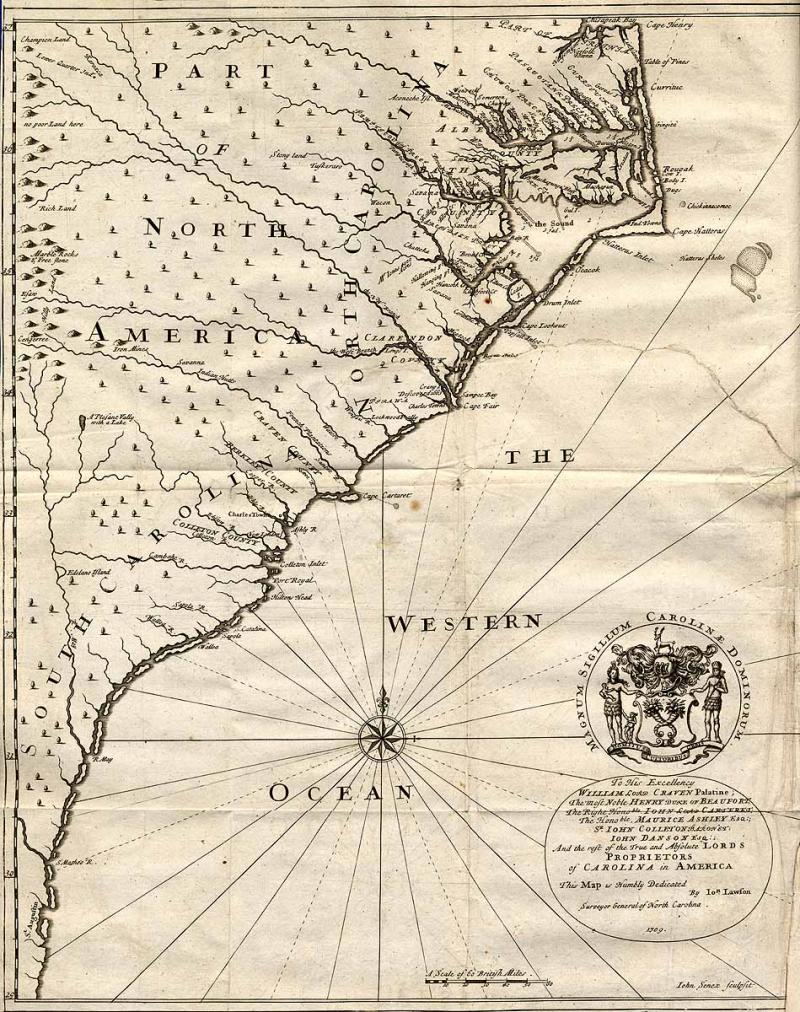I found this great account of John Lawson's 1700 exploration of the area that would become North and South Carolina, in a book written back in 1922 - History of Wake County, North Carolina, by Hope Summerell Chamberlain. It is a fantastic book, fast paced and pleasant enough that I am frankly captivated. You may see more posts inspired by it pages in the future.
Chamberlain describes Lawson's voyage:
"The first historian of North Carolina, the explorer Lawson, although known to have passed through the central part of this State, cannot actually be proved to have trod the soil of Wake County. One authority on our local history thinks that he did, and indeed it seems more than possible.Lawson made a journey through western and middle Carolina in the year seventeen hundred or thereabout. His course was a long loop coming out of South Carolina and crossing the Catawba and the ''Realkin" (or Yadkin) and other streams, continuing in a northeasterly direction and then due east, until he finally reached the settlements of the North Carolina seaboard. His descriptive traveller's journal reads as fresh and as crisply Interesting as if penned last year, and we get the impression of a writer alert in every sense and perception. He was a fine optimistic fellow, and though he was hired no doubt to praise the new colony, and so draw In settlers from among the readers of his account, yet no one can close his book without the feeling that he too, like many another coming to North Carolina to live, soon fell in love with the climate, and delighted to bask under the sunny sky.Hear his account of leaving ''Acconeechy Town" (which must have been near Hillsborough), and marching twenty miles eastward over "stony rough ways" till he reached "a mighty river." This river is as large as the Realkin, the south bank having tracts of good land, the banks high, and stone quarries. We got then to the north shore, which is poor white sandy soil with scrubby oaks. We went ten miles or so, and sat down at the falls of a large creek where lay mighty rocks, the water making a strange noise as of a great many water wheels at once. This I take to be the falls of News Creek, called by the Indians 'We-Quo-Whom.'For a first trip through an unknown wilderness, guided only by a compass, this suggests the neighborhood, and describes the granite ridges that traverse Wake County, and produce the Falls of Neuse, where the river flows across one of these barriers.During the next days' travel he comments on the land ''abating of its height" and ''mixed with pines and poor soil." This, too, makes it sound as if he perceived the swift transition which may be seen in the eastern part of Wake County from one zone to the next, from the hard-wood growth to the pine timber, and from a clay to a sandy soil.Lawson highly praised the midland of North Carolina, between the sandy land and the mountains, and it is pleasant to read his enthusiastic account of this home of ours, and learn the impression it made on a good observer in its pristine state, and before the white man's foot had become familiar with the long trading path, which must have crossed west, near this section, but not certainly in the exact longitude of Wake County. This trail is known to have passed Hillsborough, and to have crossed Haw River at the Haw Fields. It may well have followed the same course, as later did the Granville Tobacco Path, which certainly traversed Wake County near Raleigh."
 |
| Lawson's map c. 1709 |
Chamberlain really wants Lawson's path to have cut through Wake County and his descriptions of portions certainly do sound like our wild surrounds. The "large creek where lay mighty rocks," The granite ridges, the land ''abating of its height" ... ''mixed with pines and poor soil." I feel I have walked those very spots.
Was he describing "News Creek" (Neuse River)? Others feel it could easily have been the banks of the Little River.
For more insight, see Scott Heuler's blog. Scott planned and executed his own trek in Lawsons footsteps and wrote a book about it. There was an exhibit and presentation at the City of Raleigh Museum in 2019-2020.
https://www.lawsontrek.com/along-the-path-blog
For John Lawson's personal account, visit his digitized diary from 1700 at the UNC North Carolina collection here.
For John Lawson's personal account, visit his digitized diary from 1700 at the UNC North Carolina collection here.
Visit Wake County Genealogical Society's Website - Homepage | WCGS Events | Join WCGS | Publications | Wake Cemetery Survey Images | Society Surnames | Digital Resources | History Resources | More Links and Resources | Contact - info(at)wakecogen(dot)org

No comments:
Post a Comment